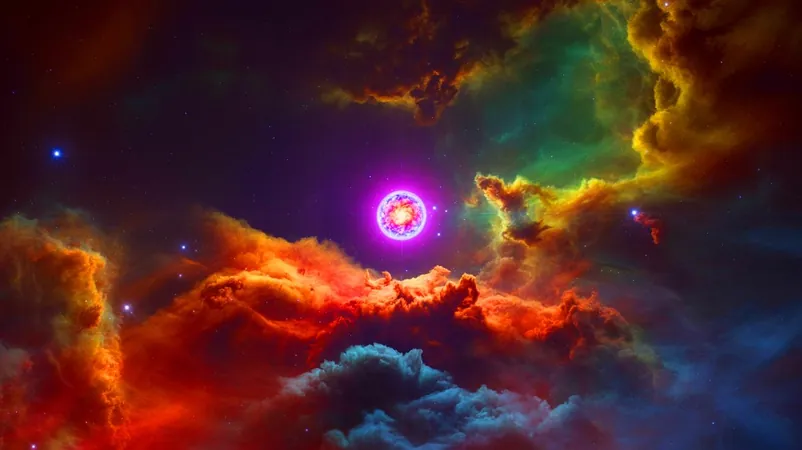
Shocking Discovery: Japanese Astronomers Capture Stunning Imagery of Young Star Formation 26,000 Light Years Away!
2025-09-09
Author: Chun
A Cosmic Breakthrough
In a groundbreaking revelation, Japanese astronomers have captured breathtaking images of a young star's formation located in a distant corner of the Milky Way. Utilizing the Atacama Large Millimeter/submillimeter Array (ALMA) in Chile, they observed the protostar known as Sh 2-283-1a SMM1—an astonishing 26,000 light-years from Earth and 51,000 light-years from the galactic center. This extraordinary find sheds light on the intricate dance of star formation in chemically unique environments, revealing how universal forces shape the cosmos.
Unveiling the Protostar Jets
Thanks to the ALMA observatory, researchers honed in on Sh 2-283-1a SMM1, a budding star enveloped in its cradle of gas and dust. They captured dazzling images of high-speed jets shooting from the star in opposite directions, along with broader, slower-moving outflows. Remarkably, these jets burst forth in cycles every 900 to 4,000 years, a pattern essential for stellar growth that allows stars to shed excess mass while drawing in material from their surrounding disks.
A First in the Outer Galaxy
This study marks a historic first, as the jets have never before been resolved in a star so far from the galactic core. Chemical analysis revealed a decreased ratio of silicon monoxide to carbon monoxide in comparison to similar stars closer to the center, indicating that shock chemistry and dust properties change in the outer galaxy, where heavier elements are scarce. This discovery emphasizes that while the physics of star formation is consistent, the chemistry varies with local conditions.
The Rare Hot Core Discovery
The protostar Sh 2-283-1a SMM1 stands out as a remarkable subject for study. With a luminosity around 6,700 times that of the Sun, it signals the potential of becoming a high-mass star. Notably, the discovery of a hot core near the star—a warm, chemically rich area—is exceptionally rare in the outer galaxy, marking just the second detection of its kind.
Adding another layer of intrigue, ALMA detected signs of complex organic molecules, hinting at the potential for planet formation. The observatory also identified molecular outflows coming from four other nearby protostars, demonstrating that the process of star formation is robust even within these remote, chemically primitive regions.
Insights from the Study
This groundbreaking study demonstrates that the fundamental physics governing star formation is consistent throughout the galaxy, regardless of the local metal richness. As lead author Toki Ikeda noted, “By resolving jets and outflows in a protostar so far out in the galaxy, we see that the same physics shaping stars close to us also operates in low-metallicity environments.”
The chemical differences found in these outer-galaxy stars highlight the impact of local conditions on the materials available for star and planet formation. These insights reach beyond our own Milky Way, providing clues about the formation of the universe's earliest stars. The research underscores ALMA's unmatched ability to delve into the universe’s mysteries by capturing clear images of celestial phenomena at unprecedented distances.
The Road Ahead: Future Research and Implications
Building on this thrilling discovery, researchers plan to study more protostars in the galaxy’s outskirts to identify if ejection cycles and molecular compositions differ with metallicity. This ongoing research promises to enrich our understanding of star formation in diverse cosmic settings, shedding light on the evolutionary history of the universe.
By deepening our knowledge of how various conditions influence star and planet formation, scientists can better predict the developmental paths of different galactic regions and assess the potential for extraterrestrial life.
This remarkable study enhances our grasp of stellar evolution and the diversity of cosmic environments. As we venture further into these distant realms, the exciting question remains: what other secrets of star formation will we uncover, and how might they reshape our understanding of the universe's origins?




 Brasil (PT)
Brasil (PT)
 Canada (EN)
Canada (EN)
 Chile (ES)
Chile (ES)
 Česko (CS)
Česko (CS)
 대한민국 (KO)
대한민국 (KO)
 España (ES)
España (ES)
 France (FR)
France (FR)
 Hong Kong (EN)
Hong Kong (EN)
 Italia (IT)
Italia (IT)
 日本 (JA)
日本 (JA)
 Magyarország (HU)
Magyarország (HU)
 Norge (NO)
Norge (NO)
 Polska (PL)
Polska (PL)
 Schweiz (DE)
Schweiz (DE)
 Singapore (EN)
Singapore (EN)
 Sverige (SV)
Sverige (SV)
 Suomi (FI)
Suomi (FI)
 Türkiye (TR)
Türkiye (TR)
 الإمارات العربية المتحدة (AR)
الإمارات العربية المتحدة (AR)